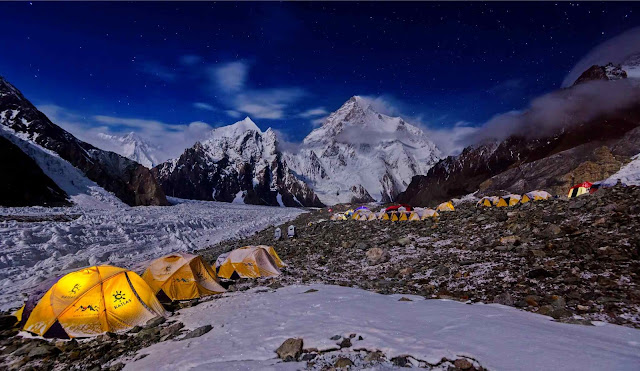
K2 has the reputation of being the world’s most difficult mountain and one of the most dangerous. Other mountains and routes may surpass K2 in difficulty but when combined with the altitude, the world’s 2nd tallest at 28,251′ has to be near the top.
There are about 10 named routes on K2. When asked what is the easiest route, most people who have climbed K2, say simply there are no easy routes on K2. If forced, they cite the Abruzzi as the one most climbed thus the “easiest”, however it also has the most deaths due to its popularity.
Why is it called K2?
In the mid-19th century the British forces in India began surveying peaks and passes in the Himalayan range in order to keep a watchful eye on any possible route that a Russian army might take if it invaded South Asia.
In 1856 Thomas Montgomerie arrived in the area of the Karakoram where K2 lies and began, somewhat unimaginatively, naming all the major peaks there "K "for Karakoram" plus a number. K2 was the second peak he surveyed. All the other peaks have since been given new names such as Broad Peak and Gasherbrum, but for some reason K2 has stuck. Chinese and Balti speakers usually call the mountain Qogir or Chogori (Big Mountain).
Who first conquered it?
The first successful ascent was made by two Italians, Lino Lacedelli and Achille Compagnoni, on 31 July 1954, but not before a number of climbing disasters had already turned K2 into a legend among the world's mountaineering fraternity. The Italians used oxygen and a large party to tackle the summit along the now commonly traversed south-eastern ridge known as the Abruzzi Spur. An American expedition a year earlier resulted in one of the most dramatic rescues in climbing history when a single climber managed to hold on to five other colleagues who had fallen using nothing more than an ice pick.
And who followed?
No one for 23 years until the second ascent by the Japanese climber Ichiro Yoshizawa in 1977. Since then around 280 people have reached K2's summit – a paltry number compared to the 3,681 who have made their way to the top of Everest. The first woman to conquer K2 was Poland's Wanda Rutkiewicz in 1986. Rutkiewicz died shortly afterwards trying to scale Kangchenjunga (8,586m). The next five women to climb K2 either died on the way down or on their next major climb, leading some to speculate that K2 was cursed for female climbers. The curse, however, has since been broken.
So what makes K2 so dangerous?
"It's enormous, very high, incredibly steep and much further north than Everest which means it attracts notoriously bad weather," says Britain's most celebrated mountaineer Sir Chris Bonnington, who lost his colleague Nick Escourt in an avalanche on K2's western side during an expedition in 1978. In 1986 13 climbers were killed in a week when a vicious storm stranded numerous expeditions.
Although Everest is 237m taller, K2 is widely perceived to be a far harder climb. "It's a very serious and very dangerous mountain," adds Sir Chris. "No matter which route you take it's a technically difficult climb, much harder than Everest. The weather can change incredibly quickly, and in recent years the storms have become more violent. People who have recently been there have told me that the snow conditions are also getting worse."

So what is the secret to a successful ascent?
According to the mountaineering historian Ed Douglas, "You have to be really good and lucky." The problem, he explains, is that although the final day of climbing, from Camp 4 to the summit, is approximately the same as Everest's final day it is steeper and more dangerous, making it physically exhausting. "It's a very long summit day. The climb is technically demanding and even once you get past The Bottleneck there's still a long way to go to the top. You only have to look at the list of those who have died on K2 to see that it contains some very accomplished climbers."
Traditionally most climbers have decided against using oxygen in favour of a light, fast ascent but in recent years cylinders have made a comeback. In 2004 more than half of the 47 summiteers used oxygen.
The most significant danger on K2 comes from rock fall and avalanches. The huge ice serac looming near the summit is the clearest objective danger as it can release large parts with zero notice falling directly on the most popular route.
The rock fall is ever-present, sending large and small objects directly on top of climbers in the narrow gullies that cannot be avoided. The best helmets cannot protect climbers from these meteors.

Also K2’s weather is notorious for its unpredictability and sudden development trapping climbers high on steep slopes. High winds can develop sweeping climbers off the high ridges, heavy snowfall can destroy fixed lines and escape routes plus accelerate the avalanche danger.
Given the steep, icy and avalanche prone terrain, falls are prevalent. Some climbers fall even when attached to fixed rope but most are not clipped in, a mistake or perhaps unavoidable, slipping down steep icy slopes where self arrest is not an option.
As if all of this is not enough to make any sane person avoid K2, there is the fact that climbers are above 20,000 or 25,000 feet, struggling for oxygen, pushing their bodies to the physiological limit climbing steep and dangerous terrain with no relief. Many climbers die simply from exhaustion, for lack of a better term.

Comments
Post a Comment